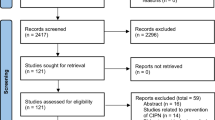Abstract
Purpose
Chemotherapy-induced peripheral neuropathy (CIPN) is a devastating pain condition of cancer therapy that may force chemotherapy dose reduction or discontinuation. Since treatment options for CIPN are quite limited, we investigated the effect of 10% amitriptyline cream on neuropathic pain.
Patients and methods
This pilot study enrolled patients with hematological or solid tumors presenting hands and feet CIPN (for less than 1 month without previous treatment for CIPN [Group 1]; for more than 1 month with previous treatment [Group 2]). Patients applied 10% amitriptyline cream twice a day. Pain intensity was evaluated at 1, 2, and 4 weeks then monthly up to 1 year. The primary endpoint was change from baseline to 4-week treatment in median pain score assessed by visual analogue scale (VAS).
Results
Overall, 44 patients were enrolled. Median (range) age was 67 (46–80) years, 34% were female. The majority (88.6%) had hematological malignancies, and the most commonly used chemotherapeutic agents were bortezomib and oxaliplatin. The median (range) VAS pain score decreased from 7 (4–9) at baseline to 2 (0–4) after 4-week topical treatment. No difference was seen between Group 1 and Group 2. Reduced initial chemotherapy doses in 11 patients as well as chemotherapy discontinued in 5 patients at baseline were resumed after treatment with 10% amitriptyline cream.
Conclusion
Considering the limited efficacy of conventional systemic treatments in CIPN and their safety profile, 10% topical amitriptyline appears to be a good candidate for first-line CIPN therapy, allowing continuation of chemotherapy at effective doses. The results are worth to be confirmed in a placebo-controlled clinical trial.

Similar content being viewed by others
References
Cavaletti G, Zanna C (2002) Current status and future prospects for the treatment of chemotherapy-induced peripheral neurotoxicity. Eur J Cancer 38(14):1832–1837
Marchettini P, Lacerenza M, Mauri E, Marangoni C (2006) Painful peripheral neuropathies. Curr Neuropharmacol 4(3):175–181
Bakogeorgos M, Georgoulias V (2017) Risk-reduction and treatment of chemotherapy-induced peripheral neuropathy. Expert Rev Anticancer Ther 17(11):1045–1060
Smith EM, Pang H, Cirrincione C et al (2013) Effect of duloxetine on pain, function, and quality of life among patients with chemotherapy-induced painful peripheral neuropathy: a randomized clinical trial. JAMA 309(13):1359–1367
Kautio AL, Haanpaa M, Saarto T, Kalso E (2008) Amitriptyline in the treatment of chemotherapy-induced neuropathic symptoms. J Pain Symptom Manag 35(1):31–39
Barton DL, Wos EJ, Qin R, Mattar BI, Green NB, Lanier KS, Bearden JD, Kugler JW, Hoff KL, Reddy PS, Rowland KM, Riepl M, Christensen B, Loprinzi CL (Jun 2011) A double-blind, placebo-controlled trial of a topical treatment for chemotherapy-induced peripheral neuropathy: NCCTG trial N06CA. Support Care Cancer 19(6):833–841
Gewandter JS, Mohile SG, Heckler CE, Ryan JL, Kirshner JJ, Flynn PJ, Hopkins JO, Morrow GR (2014) A phase III randomized, placebo-controlled study of topical amitriptyline and ketamine for chemotherapy-induced peripheral neuropathy (CIPN): a University of Rochester CCOP study of 462 cancer survivors. Support Care Cancer 22(7):1807–1814
Liebregts R, Kopsky DJ, Hesselink JM (2011) Topical amitriptyline in post-traumatic neuropathic pain. J Pain Symptom Manag 41(4):e6–e7
Kopsky DJ, Keppel Hesselink JM (2011) Multimodal stepped care approach involving topical analgesics for severe intractable neuropathic pain in CRPS type 1: a case report. Case Rep Med 2011:319750
Kopsky DJ, Liebregts R, Keppel Hesselink JM (2012) Central neuropathic pain in a patient with multiple sclerosis treated successfully with topical amitriptyline. Case Rep Med 2012:471835
Kopsky DJ, Hesselink JM (2012) High doses of topical amitriptyline in neuropathic pain: two cases and literature review. Pain Pract 12(2):148–153
Medicines and Healthcare products Regulatory Agency. Amitriptyline 25mg Tablets BP (PL 15755/0028) [Internet]. Available from: http://www.mhra.gov.uk/home/groups/par/documents/websiteresources/con2023371.pdf. 2006. [Accessed 29th December 2017]
Sawynok J, Reid AR, Esser MJ (1999) Peripheral antinociceptive action of amitriptyline in the rat formalin test: involvement of adenosine. Pain 80(1–2):45–55
Esser MJ, Sawynok J (1999) Acute amitriptyline in a rat model of neuropathic pain: differential symptom and route effects. Pain 80(3):643–653
Sandroni P, Davis MD (2006) Combination gel of 1% amitriptyline and 0.5% ketamine to treat refractory erythromelalgia pain: a new treatment option? Arch Dermatol 142(3):283–286
Acknowledgments
The authors thank Necker-enfants malades Hospital, the Assistance Publique-Hôpitaux de Paris; and Thomas Rohban, MD, from Partner 4 Health, for his advice and for the writing of the manuscript. The work of CG is supported by École de l’Inserm-Liliane Bettencourt.
Author information
Authors and Affiliations
Contributions
CG designed and conducted the study, enrolled patients, analyzed the data, and wrote the manuscript. JR, SH, and BC enrolled and monitored patients, and collected the data. OH and MLV referred patients, and contributed to the review of the data and the manuscript. FL contributed to the review of the data and the manuscript.
Corresponding author
Ethics declarations
Informed consent was obtained from all patients prior to enrolment in the study. The study was approved by the Research Ethics Committee of the Hôpitaux Universitaires Paris-Ouest (HUPO), and by the French Data Protection Authority (Commission Nationale de l’Informatique et des Libertés, CNIL).
CG is acknowledged as inventor of a patent application owned by the compagny Algo Therapeutix SAS.
The authors have full control of all primary data and agree to allow the journal to review their data if requested.
Conflicts of interest
The authors declare that they have no conflicts of interest.
Additional information
Publisher’s Note
Springer Nature remains neutral with regard to jurisdictional claims in published maps and institutional affiliations.
Julien Rossignol and Benoit Cozzi are the first co-authors.
Electronic supplementary material
ESM 1
(DOCX 21 kb)
Rights and permissions
About this article
Cite this article
Rossignol, J., Cozzi, B., Liebaert, F. et al. High concentration of topical amitriptyline for treating chemotherapy-induced neuropathies. Support Care Cancer 27, 3053–3059 (2019). https://doi.org/10.1007/s00520-018-4618-y
Received:
Accepted:
Published:
Issue Date:
DOI: https://doi.org/10.1007/s00520-018-4618-y




